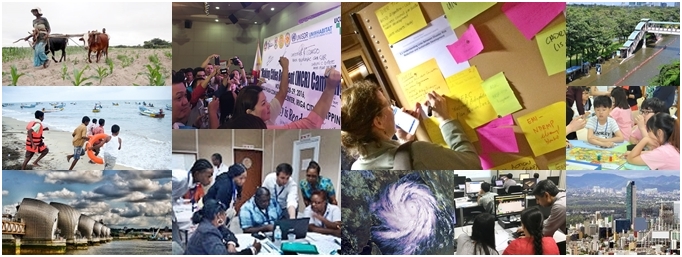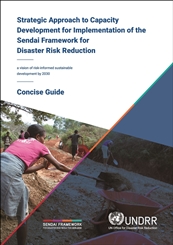Capacity development
Strategic Approach to Capacity Development for Implementation of the Sendai Framework for Disaster Risk Reduction
A Vision of Risk-Informed Sustainable Development by 2030

This Strategic Approach to Capacity Development for Implementation of the Sendai Framework for Disaster Risk Reduction seeks to establish among all stakeholders a common understanding of capacity development within the disaster risk reduction (DRR) context. By characterizing outstanding capacity development needs in light of common obstacles and constraints, presenting key principles, elements, and actions that together help guide planning discussions, providing targets and ideals, and normalizing practice across sectors, improvement of practical standards will occur.

This Strategic Approach is a resource of empowerment for all relevant capacity development partners and stakeholders, and its goal - A Vision of Risk-Informed Sustainable Development by 2030. It provides generalized advice on the capacity development roles and responsibilities of various DRR stakeholders, and high-level guidance in six critical areas of need. It is designed to be a living document to reflect changes in needs and trends over time, and this space is envisaged to evolve into a platform to capture and share lessons learned, best practices, and examples.
Background
The Sendai Framework for Disaster Risk Reduction recognizes the State’s primary role in facilitating the achievement of its disaster risk reduction (DRR) goal and priorities and highlights the criticality of sharing these responsibilities with other stakeholders and realizing an all-of-society approach.
UN Member States have identified a need for implementation support and enhancement of the capacity of institutions and individuals dealing with DRR, and in implementation of the technical support requirements of the Sendai Framework itself. Without adequate capacity and mechanisms for its implementation, it will be impossible to achieve the Sendai Framework targets. The pursuit of more collaborative and coordinated efforts to deal with increasingly limited resources is required as global progress towards meeting DRR targets advances.
Given this need, from mid-2017 to March 2018, the UNISDR facilitated consultations and study of prevailing DRR-specific capacity development needs of Member States in collaboration with UN entities, partners, and DRR stakeholders for the purpose of developing a more effective strategic approach, during which a broad range of needs, ideas, and approaches were identified and assessed, a baseline notion of success emerged.
This Strategic Approach is therefore a living resource of empowerment for all relevant capacity partners and stakeholders, and its goal A Vision of Risk-Informed Sustainable Development by 2030. It provides generalized advice on the capacity development roles and responsibilities of various DRR stakeholders, and high-level guidance in six critical areas of need:
- Developing and Strengthening DRR Fundamentals
- Institutionalizing DRR Capacity
- Sharing and Using Risk Information Before and After Disasters
- Establishing Collaborative Action for DRR at the National and Local Levels
- Strengthening External Support Mechanisms
- Advancing and Expanding DRR Capabilities
| View full concise guide |
|---|
| View executive summary & introduction [PDF, 4.46 MB] |
| SECTION 1: |
| Understanding Capacity Development Obstacles & Challenges [PDF, 2.42 MB] |
| This section addresses: The impact of capacity shortfalls on disaster risk reduction progress; Why a strategic approach is required; Obstacles and challenges to effective capacity development for disaster risk reduction; Linking capacity development for DRR to Agenda 2030, The Paris Agreement, and other initiatives. |
| SECTION 2: |
| Capacity Development in the Disaster Risk Reduction Context [PDF, 1.01 MB] |
| This section addresses the definitions of capacity development and capacity within the DRR context; Capacity domains, types and levels; Principles of capacity development for DRR; Foundational elements of effective CD for DRR; Pursuing CD according to a ‘Theory of Change’; the CD for DRR process. |
| SECTION 3: |
| View all Action Areas for Capacity Development for DRR [PDF, 1.40 MB] or download by area below |
| The consultative process revealed several areas for action and attention where notable influence on the capacity development (CD) process and/or the outcome of DRR for CD efforts has been identified. For each of the 18 Action Areas identified, possible actions, activities, and interventions that address the required capacity are provided. Each Action Area is presented in fact-sheet format for ease of use. Action Areas have been grouped into 6 areas for clarity. The topics included in this list will change with time as capacities are enhanced and as new needs and corresponding actions arise. The six areas for action include: |
| 1: Developing and Strengthening DRR Fundamentals [PDF, 144.77 KB] |
| The capacity to conduct the required activities and make relevant decisions is contingent on the existence of accurate and actionable data and information, the knowledge of how to use that data and information for planning purposes, and the ability to link it all back to the Sendai Framework goals and targets that the collective global risk experience has produced. This area cover 4 Action Areas:Ensuring use of loss and risk informationDisaster risk-informed development plansFunding and resource mobilization for DRRMonitoring of Sendai Framework implementation |
| 2: Institutionalizing DRR Capacity [PDF, 140.87 KB] |
| Stakeholders both within and outside of government must work together and must integrate DRR considerations into all the work they do, including work that involves assessing or developing the capacity required. This area cover 3 Action Areas:Understanding Links Between Disaster Risk Reduction and Sustainable DevelopmentUnderstanding Climate Risk Across SectorsHigh-Level Awareness and Cross-Sectoral Understanding of DRR |
| 3: Sharing and Using Risk Information Before and After Disasters [PDF, 143.74 KB] |
| Any development activity conducted in the absence of information on risk and vulnerability is likely to exacerbate community or country risk, but the ability to receive and act on such information is not intrinsic. And just as risk information is vital to pre-disaster development and preparedness activities, it is key to avoiding the roots of risk and vulnerability in the aftermath of disasters during recovery and reconstruction. This area cover 3 Action Areas:Conducting Effective Risk Communication and Knowledge ManagementEnhancing Disaster Preparedness and Planning for “Build Back Better”Understanding the Economics of DRR |
| 4: Establishing Collaborative Action for DRR [PDF, 144.82 KB] |
| Disaster risk reduction is everyone’s responsibility, from the household level to the national government level. At the other end of the spectrum, when disaster risk is shared across international borders or where hazards that exist or are created in one country threaten people, property, or the environment in another country, the capacity needs to address those issues likewise become interconnected and concerted action is required. This area cover 3 Action Areas:Establishing an ‘All-of-Society’ ApproachDRR at Local Government LevelDRR at Community Level |
| 5: Strengthening External Support Mechanisms [PDF, 141.46 KB] |
| There are many opportunities for external partners to provide capacity development (CD) support. This area cover 3 Action Areas:South-South and Peer-to-Peer MechanismsUN Country TeamsHumanitarian Development Nexus |
| 6: Advancing and Expanding DRR Capabilities [PDF, 144.20 KB] |
| Current and future generations of DRR professionals need the right skills and resources to do what is required of them. Innovation, fueled by investments in research and development, offers many new and unexpected opportunities to close capacity gaps. This area cover 2 Action Areas:Education for Disaster Risk ReductionInnovation and Use of Technology for DRR |
| SECTION 4: |
| Stakeholders and Partners [PDF, 3.62 MB] |
| Effective capacity development (CD) depends on the involvement of all stakeholders, all partners, and all of society. Stakeholders may become involved as a provider of CD assistance, as a recipient of training or some other benefit through interventions, or perhaps a mix of provider and recipient roles. During the consultative process, workshop and survey participants worked to characterize in broad and inclusive terms the CD for DRR roles and responsibilities of each of the following stakeholder categories for which roles and responsibilities are listed:NGOs and CSOsAcademiaIndividuals and HouseholdsRegional Organizations Including IGOsThe UN, IGOs, and IFIs |
| SECTION 5: |
| Anchors for Effective Capacity Development for DRR [PDF, 2.89 MB] |
| Operationalization of the strategic approach by stakeholders engaged in capacity development (CD) for DRR must be comprehensive and sustained. This section elaborates anchors that can help to strengthen and institutionalize CD and the actions required to make it successful, including through:Raising awareness on need for capacity development and strategic plans for CDNationally-based and Sendai Framework-relevant evaluation indicatorsExpanding South-South, triangular and other opportunities through a marketplaceProviding nationally- and locally-relevant Sendai Framework-focused target capability standardsStrengthening advancement and professionalization of DRR capacities and capabilitiesUnited Nations engagements |
| Appendices [PDF, 429.32 KB] |
| Appendix 1: Relationships Between the Strategic Approach and the Sendai Framework for Disaster Risk Reduction (Sendai Framework) [PDF, 98.44 KB] |
| Appendix 2: The Consultative Process and List of Consultations [PDF, 105.11 KB] |
| Appendix 3: Select Capacity Development Planning Tools, list with links [PDF, 50.21 KB] |
| Appendix 4: Capacity Development Obstacles [PDF, 128.07 KB] |
| Appendix 5: Driving Principles of Effective Capacity Development [PDF, 115.77 KB] |
| Appendix 6: Foundational Elements of Effective Capacity Development [PDF, 94.15 KB] |
| Appendix 7: Capacity Development Planning Questionnaire [PDF, 62.69 KB] |
| Appendix 8: Checklist of Capacity Development for Disaster Risk Reduction Principles [PDF, 88.41 KB] |
| Appendix 9: Checklist of Common Capacity Development for Disaster Risk Reduction Obstacles [PDF, 155.50 KB] |
| Appendix 10: Capacity Development Process, 6 steps [PDF, 166.37 KB] |
| Appendix 11: Proposed Indicators for Monitoring and Evaluation of Capacity Development for Disaster Risk Reduction [PDF, 105.55 KB] |
| Appendix 12: Summary of Priority Areas and Actions for Capacity Development [PDF, 54.33 KB] |
| Appendix 13: Capacity Development Strategy Examples and Guidance [PDF, 50.98 KB] |
| References and Key Resources [PDF, 77.14 KB] |
Related Links
- Zero draft of the Global Capacity Development Strategy in support of the implementation of the Sendai Framework for Disaster Risk Reduction [PDF, 864 KB]
- Report of the Global expert consultation on the zero draft of the Global Capacity Development Strategy [PDF, 6,198.78 KB]
- Global expert consultation on the zero draft of the Global Capacity Development Strategy in support of the implementation of the Sendai Framework for Disaster Risk Reduction